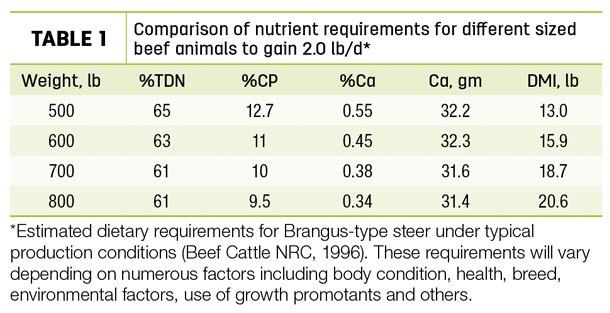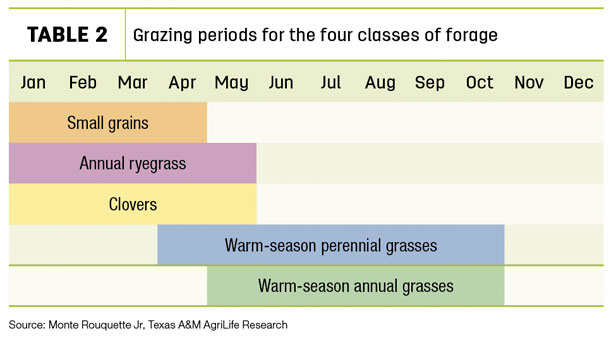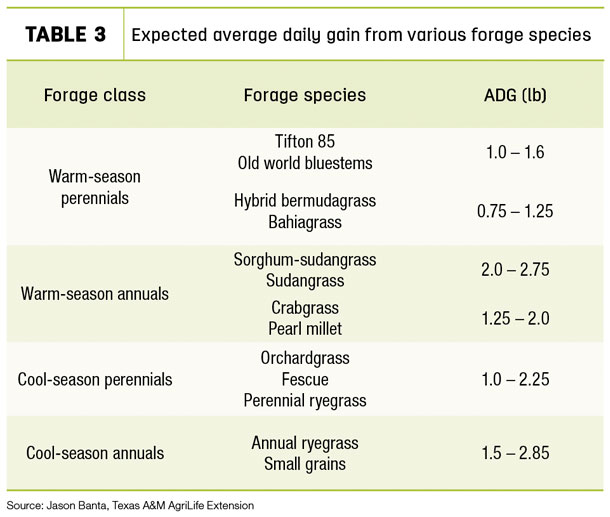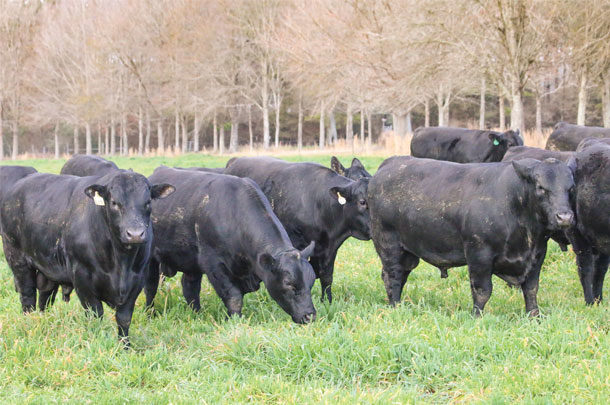The only exception is milk or milk replacer consumed prior to weaning and routine vitamin and mineral supplementation. To qualify as grass-fed, animals cannot consume grain or grain products and must have continuous access to pasture during the growing season. Hay, haylage, baleage, silage, crop residue without grain and other roughage sources are acceptable feed sources.
There are basically three stages of beef production. The cow-calf producer weans calves at approximately 6 to 10 months of age, weighing 450 to 700 pounds. Younger and lighter calves are backgrounded either on the ranch or in a stocker operation. In a conventional system, stockers may receive a small amount of grain supplement primarily for the purpose of teaching them to eat from a trough. At 18 to 22 months of age, weighing 700 to 800 pounds, calves are moved to a feedlot where they are given primarily a grain diet. They are fed until about 18 to 22 months of age and to a weight of 1,200 to 1,400 pounds. In grass-fed systems, cattle receive only forage through all three production stages.
An average daily gain (ADG) of 2 pounds per day is needed to put enough fat on an animal to produce a desirable carcass. The amount of nutrients required to produce this amount of gain at various animal weights is shown in Table 1.

TDN is total digestible nutrients, a measure of energy. CP stands for crude protein and Ca is calcium. Both TDN and CP requirements are expressed as a percentage of the total diet, whereas calcium requirements are shown as a percentage of diet and grams. TDN and CP are measures of forage quality, whereas DMI (dry matter intake) is a measure of forage quantity needed by the animal to produce the desired amount of ADG.
In grass-fed beef production, the required nutrients normally come from forage in year-round grazing systems with or without supplementation of hay, haylage, baleage or silage.
Forage classes
“Year-round grazing systems often involve the use of all four forage classes – warm-season perennial grasses, warm-season annual grasses, cool-season perennial forages and cool-season annual forages. Warm-season perennial grasses normally provide grazing from April through October, depending on the area,” says Dr. Monte Rouquette Jr., Texas A&M AgriLife Research. “Examples of warm-season perennial grasses are bermudagrass, dallisgrass, bahiagrass, bluestems, eastern gamagrass, indiangrass, sideoats grama and switchgrass. Warm-season annual grasses include pearl millet, sorghum-sudangrass and crabgrass. These grasses can provide good quality grazing from May through October.”
Cool-season perennial forages include tall fescue, orchardgrass, perennial ryegrass and alfalfa. The cool-season perennial grasses generally provide grazing from April until early June in states north of Texas. They do not grow well in Texas and many southern states. Alfalfa can provide five to six months of grazing during various times of the year depending on the area and variety.
“Cool-season annual forages include clovers, annual ryegrass and small grains,” Rouquette says. “Cool-season clovers provide grazing from February through April, annual ryegrass from January through May and small grains from January through April.”
“There is a stand establishment risk with cool-season annuals,” says Dr. Jason Banta, Texas A&M Extension. “The highest risk is with legumes. Less risk is associated with small grains and the least risk is with annual ryegrass.”
Grazing periods for the four forage classes are shown in Table 2.

Meeting animal needs
“Successful beef producers monitor forage quantity and quality,” says Dr. Bruce Carpenter, Texas A&M AgriLife Extension. “Forage quantity is often successfully estimated by experienced grazing managers by simply walking through a pasture and recording what they see. Inexperienced managers should clip forage samples from at least 10 representative locations across a pasture, combine the samples, dry them and then weigh the dry matter. An easier method is to measure stubble height with a grazing stick and use the formula printed on the stick to convert inches of plant height to pounds of forage.”
“To provide enough forage for growing cattle [stockers], plant about 1 acre of a cool-season annual for every one-and-one-half to two steers. Finishing cattle require about 1 acre for every steer,” says Banta. “Plant about 1 acre of pasture for every two to three spring-calving cows. To maintain good forage production, limit grazing to two hours per day or one day for every four to five days on hay or dormant forage. Increase grazing time in spring when forage production increases and after cows have calved.”
For fall calving, plant about 1 acre of pasture for every cow. Exercise full-time grazing from December through March as forage production allows. From March through the summer, pastures should produce adequate amounts of forage.
Low-quality forage fails to supply the needed nutrients to support animal growth and reduces dry matter intake. Forage quality is determined by forage species, pasture growing conditions and fecal consistency. Expected ADG from various forage species, shown in Table 3, are useful for drafting the grazing calendar.

Cattle nutrient intake is indicated by fecal consistency (see Manure scoring determines supplementation needs). If fecal consistency suggests additional CP or TDN is needed, the grass-fed calf producer needs to supplement animal diets with a good-quality forage such as hay or silage.
“Forage quantity and quality needs are governed by cattle reproduction stage,” says Banta. “For example, spring calving optimizes forage resources for the cow herd, since the calves will do very little grazing during this period. If calves only have ADG of 0.75 pounds during their growing period, they will not be ready for finishing until winter of the following year. Proper finishing of these calves will require a decent quality of winter annuals. If calves in the spring-calving system have an ADG of 1.5 pounds, they will be ready for finishing during summer of the following year and will require a high-quality summer annual.”
A fall-calving system needs good winter pasture for the cow herd and for the calves during the latter part of their growing phase. A majority of the finishing phase is during a period of abundant forage production, and ADG of 1.5 pounds is achievable. Late-maturing winter annuals are needed for end of the finishing phase.
Grass-fed beef producers must develop a forage management plan that provides the nutrient requirements for cow herd maintenance and timely calf growth and finish. ![]()
PHOTO: Grass-fed beef requires a forage management plan that provides the nutrient requirements for cow herd maintenance and timely calf growth and finish. Photo by David Cooper.
Robert Fears is a freelance writer based in Georgetown, Texas.










